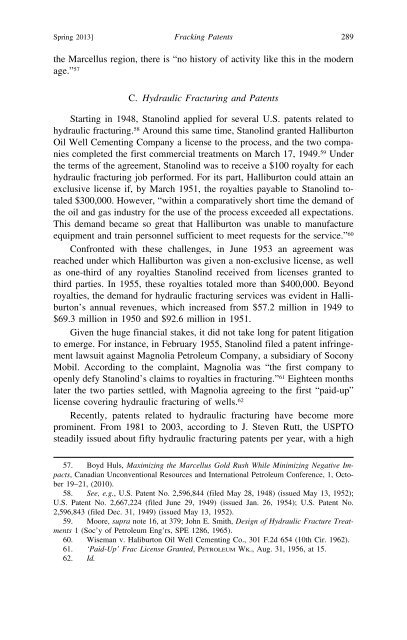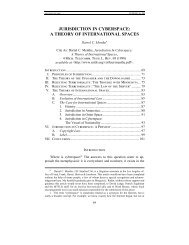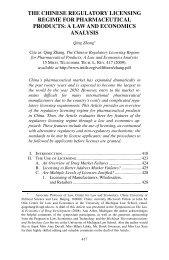Fracking Patents - Michigan Telecommunications and Technology ...
Fracking Patents - Michigan Telecommunications and Technology ...
Fracking Patents - Michigan Telecommunications and Technology ...
- No tags were found...
You also want an ePaper? Increase the reach of your titles
YUMPU automatically turns print PDFs into web optimized ePapers that Google loves.
Spring 2013] <strong>Fracking</strong> <strong>Patents</strong> 289the Marcellus region, there is “no history of activity like this in the modernage.” 57C. Hydraulic Fracturing <strong>and</strong> <strong>Patents</strong>Starting in 1948, Stanolind applied for several U.S. patents related tohydraulic fracturing. 58 Around this same time, Stanolind granted HalliburtonOil Well Cementing Company a license to the process, <strong>and</strong> the two companiescompleted the first commercial treatments on March 17, 1949. 59 Underthe terms of the agreement, Stanolind was to receive a $100 royalty for eachhydraulic fracturing job performed. For its part, Halliburton could attain anexclusive license if, by March 1951, the royalties payable to Stanolind totaled$300,000. However, “within a comparatively short time the dem<strong>and</strong> ofthe oil <strong>and</strong> gas industry for the use of the process exceeded all expectations.This dem<strong>and</strong> became so great that Halliburton was unable to manufactureequipment <strong>and</strong> train personnel sufficient to meet requests for the service.” 60Confronted with these challenges, in June 1953 an agreement wasreached under which Halliburton was given a non-exclusive license, as wellas one-third of any royalties Stanolind received from licenses granted tothird parties. In 1955, these royalties totaled more than $400,000. Beyondroyalties, the dem<strong>and</strong> for hydraulic fracturing services was evident in Halliburton’sannual revenues, which increased from $57.2 million in 1949 to$69.3 million in 1950 <strong>and</strong> $92.6 million in 1951.Given the huge financial stakes, it did not take long for patent litigationto emerge. For instance, in February 1955, Stanolind filed a patent infringementlawsuit against Magnolia Petroleum Company, a subsidiary of SoconyMobil. According to the complaint, Magnolia was “the first company toopenly defy Stanolind’s claims to royalties in fracturing.” 61 Eighteen monthslater the two parties settled, with Magnolia agreeing to the first “paid-up”license covering hydraulic fracturing of wells. 62Recently, patents related to hydraulic fracturing have become moreprominent. From 1981 to 2003, according to J. Steven Rutt, the USPTOsteadily issued about fifty hydraulic fracturing patents per year, with a high57. Boyd Huls, Maximizing the Marcellus Gold Rush While Minimizing Negative Impacts,Canadian Unconventional Resources <strong>and</strong> International Petroleum Conference, 1, October19–21, (2010).58. See, e.g., U.S. Patent No. 2,596,844 (filed May 28, 1948) (issued May 13, 1952);U.S. Patent No. 2,667,224 (filed June 29, 1949) (issued Jan. 26, 1954); U.S. Patent No.2,596,843 (filed Dec. 31, 1949) (issued May 13, 1952).59. Moore, supra note 16, at 379; John E. Smith, Design of Hydraulic Fracture Treatments1 (Soc’y of Petroleum Eng’rs, SPE 1286, 1965).60. Wiseman v. Haliburton Oil Well Cementing Co., 301 F.2d 654 (10th Cir. 1962).61. ‘Paid-Up’ Frac License Granted, PETROLEUM WK., Aug. 31, 1956, at 15.62. Id.






